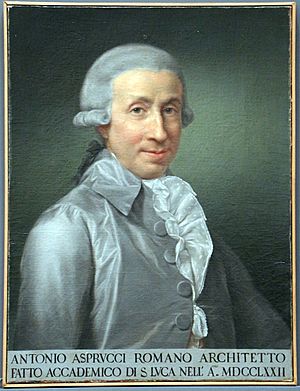Antonio Asprucci facts for kids
Quick facts for kids
Antonio Asprucci
|
|
|---|---|

Portrait of Antonio Asprucci by Anton von Maron
|
|
| Born | 20 May 1723 |
| Died | 14 February 1808 (aged 84) |
| Known for | Architecture |
|
Works
|
|
| Movement | Neoclassicism |
Antonio Asprucci was a talented Italian architect who lived from 1723 to 1808. He is known for his beautiful buildings, especially those in the Neoclassical style. This style became popular in the late 1700s and early 1800s. It was inspired by the classic art and architecture of ancient Greece and Rome.
Contents
Life of Antonio Asprucci
Antonio Asprucci was born in Rome on May 20, 1723. He learned about architecture from a famous teacher named Nicola Salvi. Salvi was the brilliant mind behind the amazing Trevi Fountain in Rome. Asprucci helped Salvi with some of his projects.
Asprucci's Early Career
After his training, Asprucci started working on his own. He designed buildings for important people, like the Duke of Bracciano. He also built a house for Marcantonio Borghese IV in a place called Pratica di Mare.
Introducing Neoclassicism in Rome
Antonio Asprucci was one of the first architects to bring the Neoclassical style to Rome. This new style used simple, grand designs inspired by ancient Roman and Greek buildings. It was a big change from the more decorative styles that were popular before.
Working with His Son
Asprucci often worked with his son, Mario, who was also an architect. They created many projects together, especially in the famous Villa Borghese in Rome. Antonio Asprucci was also a member of the important Academy of San Luca. In 1790, he was chosen as its Principe, which means director. He passed away in Rome on February 14, 1808.
Antonio Asprucci's Famous Works
Antonio Asprucci worked on many projects, especially for the beautiful Villa Borghese in Rome. For more than 20 years, starting in 1782, he helped design the gardens of the villa.
The Temple of Aesculapius
His most famous work is a small building called the Temple of Aesculapius. This temple is located in the middle of a pond in the Villa Borghese gardens. It is a perfect example of Neoclassical architecture. The temple has a front porch with four tall columns in the Ionic style.
Other Projects in Villa Borghese
Asprucci also worked on other buildings within the Roman villa. He helped design the church of Santa Maria Immacolata in Piazza di Siena. He also reorganized the Casino della Villa Pinciana, which is now home to the amazing Galleria Borghese art museum. He helped arrange the many art objects inside the museum.
Mario Asprucci's Work
Antonio's son, Mario Asprucci, also became a well-known architect. In 1795, Mario was asked to design a classical villa called Ickworth House. This grand house is located in the countryside of Suffolk, England.
See also
 In Spanish: Antonio Asprucci para niños
In Spanish: Antonio Asprucci para niños

